
ALGAE: Algae is the unsightly dark streaks that appear on your roof, while not directly related to leaks it may be an early warning sign that your roof is beginning to show it’s age. Consider having it inspected, especially if you have just acquired your home through sale or are unsure about the age or history. On shingles greater than 10 years old this is very common to see and often times is not anything more than just unpleasant to look at, The image at left was on a 15 year old roof. If you have pine trees near your roof it is VERY important to keep the roof free from the needles as much as possible, the pine tar eats away at the shingles causing premature wear.
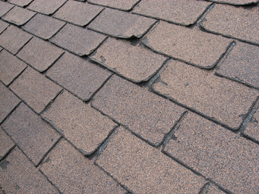
CURLING AND BUCKLING: Curling and buckled shingles are one of the most common, yet serious roof problems and should be inspected and more than likely scheduled for replacement immediately. This problem can be in indication of inadequate roof ventilation and/or inferor products and installation methods. Curled and buckled shingles cannot adequately protect the home underneath and will lead to leaks and premature wear under the roof surface. Once shingles start bucking they tend to deteriorate very rapidly and without proper planning you can find your roof has lost all protection.

GRANULE LOSS: Granule loss is generally caused by aging, prolonged weather exposure, and/or an inferior shingle product. Shingles with granule loss are much more likely to leak and should be inspected, and more than likely scheduled for replacement as soon as possible. Common observations for granule collection are in the gutters of your home and bare or thin spots that appear on the roof. This is along the same lines of curling and buckling. Most if not all of the weatherproofing properties of your roof are very close to being non existent, and once they start to deteriorate it is not long before you are at a severe risk for water damage.
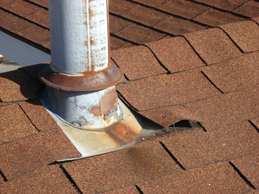
IMPROPER FLASHING: Cracked, Damaged, or Missing flashings around chimneys, vent pipes, roof vents, and other protruding objects from your roof should be inspected and properly repaired as soon as possible. When the roof sheds water down, these objects are in the direct path of moving water and act as a funnel right into your home, and can cause exterior as well as extensive interior damage.We have lifetime warranties on all roof system components but these items are about the only items that are prone to failure before the roof. We recommend inspections on a yearly basis, or at the very least every 3 years.
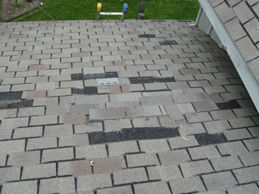
MISSING SHINGLES: Missing shingles are unsightly to look at and can be a direct path for water to enter your home, they should be replaced immediately. Excessive missing shingles could be an indicator of improper sealing, or product failure. It is one of our standard practices to look over the entire roof while we are out to do all repairs, but not all companies do this without being asked. When getting your new roof installed we can leave a spare bundle of shingles to use if the occasional shingle blows off or you get a small area of storm damage. Shingle colors don’t change that often but there is nothing worse than seeing a beautiful new roof with a few odd colored shingles. If we did your roof, please do not discard the bundle of shingles. Store them in the garage (not the attic, or they may seal together)

MOLD AND MILDEW: Mold and Mildew can be seen from within the attic of a home. This can be from a leaking roof or an improperly vented pipe going directly into the attic, or improper ventilation and insulation. This should be addressed immediately and mold remidiation may be required if the problem is severe enough since mold is a serious health hazard. The image at left was from a single nail that popped through a shingle due to poor installation, and because the water from the top roof was running directly over its path it caused quite a bit of damage.
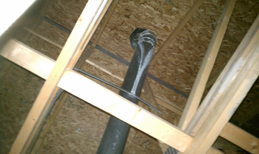
STAINS AND SPOTS: Another indicator water has penetrated into the home are stains, white or gray streaks and rusty nails in the attic. Look for discolorations and rusty nails that are showing through the plywood. Since water can travel down the rafters and trusses it may be difficult to pinpoint where the water is getting in. This should be inspected to cure the problem and to prevent further damage. Anything sticking through the roof has the capacity to leak and in the case of the furnace pipe at left, the crew that initially installed the roof (less than 10 years ago) failed to properly seal the storm collar around the pipe coming through the roof. There was an ice ball the size of a softball sitting on the insulation, luckily trapping the water from damaging the inside of the house.

ROOF ROT: Roof rot is a clear indication that the roof is long overdue for replacement. Chances are the roof is leaking and damage to the sheeting and/or structure below has taken place. The roof and structure should be inspected and scheduled for replacement immediately. If your roof looks like this, we beg you get it fixed right now! The only thing stopping your house from a torrential downpour in your living room is pure luck.
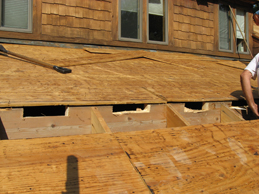
INADEQUATE VENTILATION: Inadequate ventilation is hard to spot at a glance, but if you do not see roof vents or ridge vents on your home, or your attic is abnormally hot or humid it is recommended to have it inspected. A poorly ventilated roof can lead to premature shingle wear and skyrocketting energy bills since hot air cannot escape your home the way it was designed. The image at left shows us installing new ventilation into an area that was previously blocked off, it appeared there was ventilation but the design was flawed and we spotted it during our initial inspection. This solved a long mysterious moisture and over heating problem in the room below. Another indicator of poor ventilation is sweating walls or windows.

